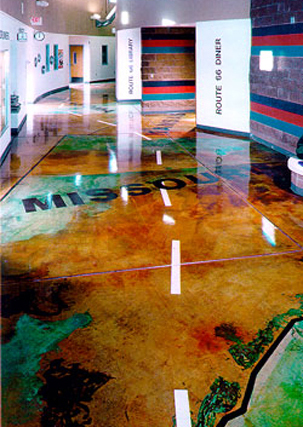 |
||||||
| January 20, 2004
In This Issue of The Acid Staining Newsletter Welcome to the Acid Staining Newsletter WELCOME TO THE ACID STAINING NEWSLETTER Greetings to all those who have an interest in acid-stained concrete! Over the last few years, I have been receiving a steadily increasing number of emails from all over the world with questions about staining projects. It has been terrific; I made some great friends, helped a lot of people create beautiful floors, and learned quite a bit myself in the process. The downside was, though we were having some really valuable discussions about staining, they were one-on-one conversations and no one else had access to this helpful information. For that reason, this year I have decided to stop answering questions by email. Instead, I will be releasing two new resources where serious stainers, professionals and do-it-yourselfers alike, can go to get the information they need to create truly awe-inspiring floors. The first new resource is this newsletter, which will cover the questions I've received most frequently over the last few years. Some of the answers I have given are covered in my books and video, but others are not. I also intend in these newsletters to share knowledge of new products and techniques which I come across during my seminars and meetings with others who are on the cutting edge of the decorative concrete field. I will let you know my honest opinion of products we have tried on the job. If I have heard about a new product which sounds promising I will pass that information on here, with a warning, if we have not actually tried it. This newsletter will let you know how I have dealt with questions of job timing, cleaning procedures and problems with colors and sealers. Secondly, for those of you who don't know, I have recently added a Forum to my website, www.gayegoodman.com. If you have specific questions you need answers to, you post them and my crew and I will respond as soon as we can. Also, please keep in mind that my staining company, Faux Real, works primarily in the dry high altitude regions of New Mexico and that concrete slabs are strongly affected by climate. If you have questions or problems which might be specific to a very different climate, posting them to the forum will allow you to tap into the knowledge of professional stainers in other parts of the world. If you have wonderful results with something new and wish to give a testimonial or let us know of your techniques, please send an email to my publisher at info@bridgeworks.com. Now let's get started! PLANNING FOR A REALLY BIG PROJECT The demand for decorative acid staining in large commercial areas is growing dramatically. It is a perfect solution for those who want a rich texture from their floors, but at a much lower cost than tile or other floor coverings. I have received emails from people who were tackling HUGE jobs of 15,000 sq. ft. or more! For the less experienced stainer, planning for a project of this size can be daunting at best!
Also, when performing a job of this size, it is important that you quote the job correctly. There are often unforeseen expenses in a job like this, and nothing is worse than finishing a job and finding you haven't made a profit. Have you thought about what you will do about insurance, workman's comp., and all the legalities if a member of your crew damages the project? Also, you will have to be sure to have a crew that will be willing to tough it out through the drudgery for a long time. It's good to have both sticks and carrots handy. For large commercial areas, you will need to go with a really durable solvent-based acrylic sealer, then let it 'gas off' for several days and apply 2 coats of On an' On or Terra Glaze wax by Spartan. The solvent sealers seem to hold dirt magnetically, so the wax makes them easier to clean as well as adding a sacrifice coat which a cleaning staff can maintain. Be sure to train the cleaning staff in the vagaries of the wax (very sensitive to water, must not be put down unless slab is at least 50 degrees F. Floor must have no dust on it prior to waxing, etc. etc.) I'll write more on this subject in upcoming newsletters. STAINING SLABS THAT HAVE BEEN POWER-TROWELLED If you are staining a new slab and have input into how the slab is poured, you may often be asked if power-trowelling the slab will cause problems when staining. The answer is almost always yes. The power trowel often makes the surface so smooth that stain only penetrates in spots. I always advise my clients who want stained floors to avoid the use of a power trowelling machine. However, huge warehouses and such are just too big to be hand-trowelled. We then specify that the machine be pre-set not to overdo it. We can usually still stain these floors by acid-washing them first with a mixture of muriatic acid (like for pools) mixed 1:4 with water. It will created a slurry on the surface which must be quickly vacuumed up and rinsed off well. The acid-wash usually opens the pores enough for a fairly even staining to occur. I can think of only one time in my staining career when we had to throw in the towel on a floor which was too slick. If a slab won't take your stain, it is more often the case that some sort of curing compound or clear sealer has been applied to the slab and the floor stainer does not recognize it.
|
||||||
|
|
||||||

